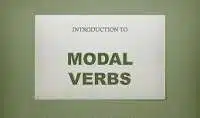Modals
Modals are the verbs which are used with other verbs (not modals) to express ability, possibility, permission, obligation etc.
Here is a list of modals :
can might need would ought to could should
shall used to may must will dare
Uses of Modals
1. Uses of Shall
A- Use of ‘shall’ with 1st person shows pure future :
- I shall be in my class at this time tomorrow.
- We shall decorate our houses for Deepawali.
B- Use of ‘shall’ with and the 2nd 3rd person shows:
1. Promise:
- You shall get a prize.
- Ile shall get Rs 500/-
2. Command:
- You shall not come to my house.
3. Threat:
- You shall be punished for your misconduct.
2. Uses of Should
‘Should’ is used to show :
1.Obligation:
- We should serve our parents.
2. Advice or recommendation:
- You should take milk, not coffee.
3. Probability or expectation:
- He was in the final year of MBBS. He should be a doctor now
3. Uses of Will
Use of `will’ with 3rd person shows pure future:
- He will be in his office at this time tomorrow.
- Use of ‘will’ with 1st and person shows :
1. Wish:
- I will go home now.
2. Request:
- Will you please lend me your scooter?
3.Determination:
- I will find out the truth.
4. Willingness:
- I will lend you my pen.
5.Threat:
- I will surely punish him.
4. Uses of Would
‘Would’ is the past tense of ‘will’. It is used to denote :
1.A polite request:
- Would you lend me your pen?
2. An enquiry about the wish of the person addressed:
- Would you like to have a cup of tea?
3. A wish:
- Would that I was the Prime Minister!
5. Uses of Can
‘Can’ is used to indicate :
1.Ability:
- He can teach you how to speak English.
2. Possibility:
- He can come at any time.
6. Uses of Could
‘Could’ is the past tense of ‘can’. It is used to indicate :
1.Ability:
- He could swim well at the age of ten.
2. Permission:
- Could! see what is in your hands?
3. A polite request:
- Could you pass on the salt, please?
7. Uses of May
‘May’ is used to indicating:
1.Permission:
- May I come in, Sir?
2. Possibility:
- It may rain Way.
3. Purpose:
- Work hard so that you may pass.
4. Wishes and hopes:
- May he win a scholarship!
8. Uses of Most
‘Must’ is used to indicate:
1.Obligation:
- You must pay your bill by the 7th of this month.
2. Advice or recommendation:
- The patient is serious. You must take him to the hospital.
3. A logical conclusion:
- You have worked a lot. You must be tired.
9. Uses of Need
‘Need’ is used to indicate obligation or necessity.
- You need not go there now. You are too late.
- Need I remind you of your promise?
10. Uses of Might
‘Might’ is used to showing:
1.Possibility:
- It might rain, but we can’t be sure.
2. Purpose (in the past):
- He worked hard so that he might pass.
11. Uses of Ought to
‘Ought to’ indicates:
1.Obligation:
- You ought to attend the class regularly.
2. Advice or recommendation:
- He ought to consult a good doctor.
12. Uses of Used to
‘Used to’ indicates:
1. A habitual action in the past:
- I used to fly kites when I was young.
2.A state of things that existed in the past:
- There used to be a restaurant here ten years ago.
13.Uses of Dare
‘Dare’ means having the courage to be brave enough.
- I do not know how he dares to say all that.
- I low dare you to disobey your parents
Some Exercises of Modals Are:-
Modal Exercises and Worksheets No. 1 & 2
Modal Exercises and Worksheets No. 3 & 4
Modal Exercises and Worksheets No. 5 & 6
Modal Exercises and Worksheets No. 7 & 8
Modal Exercises and Worksheets No. 9 & 10

